LILACS celebrated its 35th anniversary on October 29, 2020, but its history began many years earlier, in many ways intertwined with BIREME’s history, which was created in 1967, because it represents the experience and evolution of an area and an institution that was created as a MEDLARS center of the United States’ National Library of Medicine’s international information system, and which has always had the mission of democratizing scientific and technical information to respond to public health issues and health research of the countries of the region.
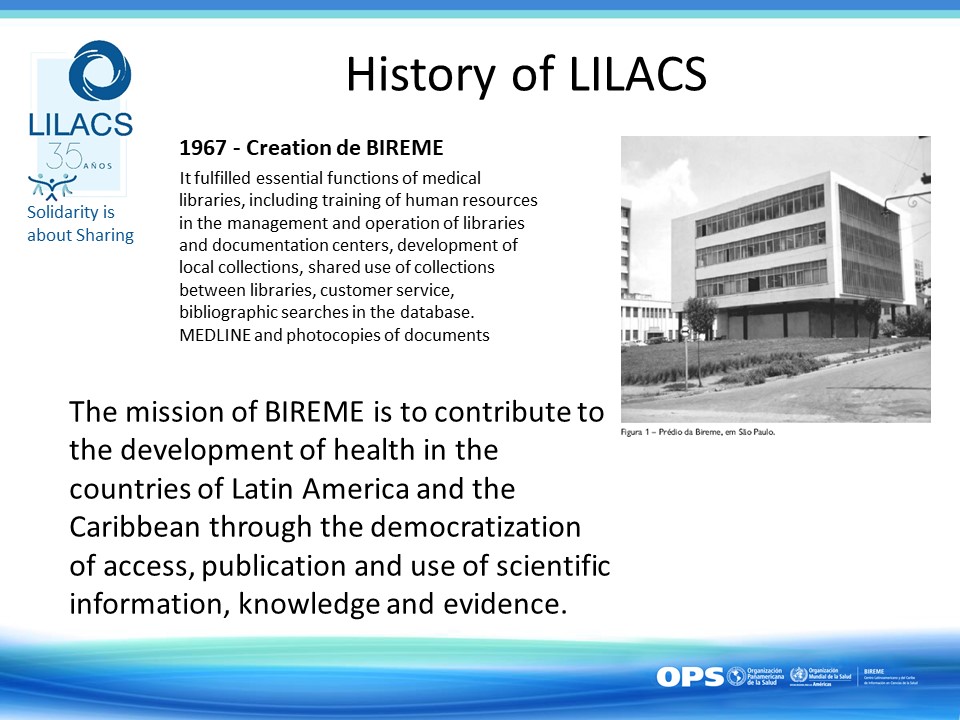 In 1976, BIREME received the recommendation of the Scientific Committee to create a bibliographic index of the Region’s literature, and in 1977 BIREME started indexing 44 Latin American MEDLINE indexed journals.
In 1976, BIREME received the recommendation of the Scientific Committee to create a bibliographic index of the Region’s literature, and in 1977 BIREME started indexing 44 Latin American MEDLINE indexed journals.
In 1979, the first edition of the IMLA – Index Medicus Latinoamericano was completed, which tripled the availability of scientific journals to 150 titles from 18 countries in the Region and marked the advance of BIREME’s performance as a library that provides the existing scientific and technical information the bibliographic control of Latin American and Caribbean journals and the strengthening of national research and scientific publishing initiatives in the area, which culminated in 1982 with the change of its name from BIREME to Latin American and Caribbean Center for Health Sciences Information.
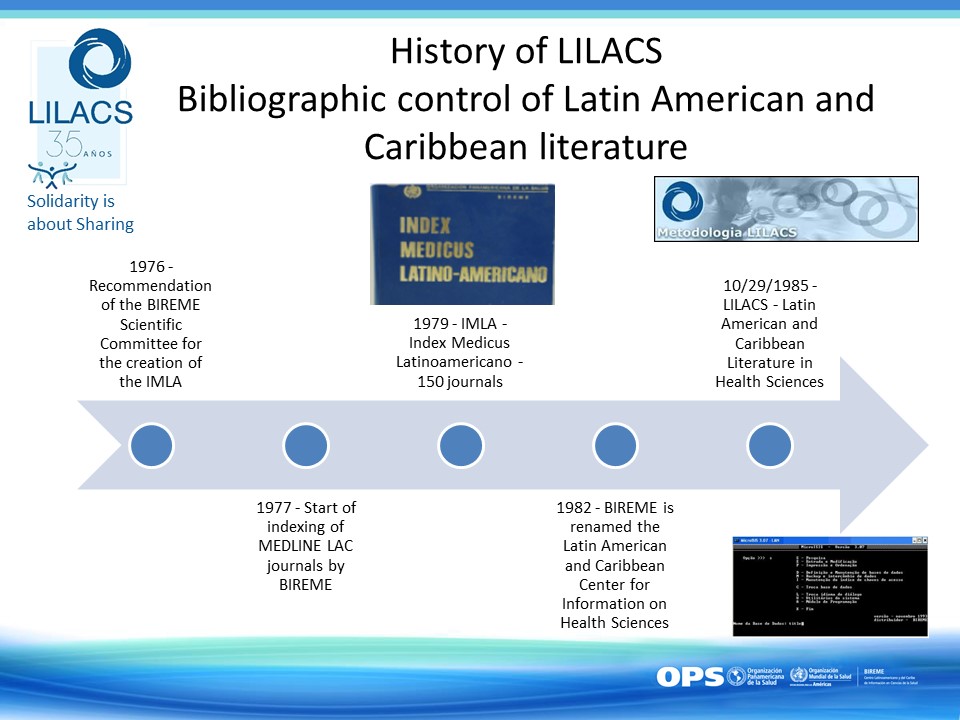 In 1985, LILACS – Latin American and Caribbean Health Science Literature was launched, with an emphasis on the coverage of the theme of Public Health. The main advances were:
In 1985, LILACS – Latin American and Caribbean Health Science Literature was launched, with an emphasis on the coverage of the theme of Public Health. The main advances were:
- Broadening the scope of types of literature, including in addition to journals, monographs, theses and unconventional documents;
- Decentralizing the collection, selection, bibliographic description and indexing for cooperating centers in Latin American and Caribbean countries;
- Using the methodology of the UNISIST Reference Manual (UNISIST, 1980) to structure bibliographic records for bibliographic indexes and instead of library catalogs, following adaptation made by CELADE (CEPAL/UN) for its DOCPOP database (Documentation on Population);
- Technologically, the operation was based on the UNESCO CDS/ISIS system that operated on the newly launched desktop computers.
Another important milestone was the publication of DeCS – Health Sciences Descriptors and the creation of the Collective Health category in 1986, which enabled the thematic indexing of documents with terms in Portuguese and Spanish (translation of the Medical Subject Headings of the National Library of Medicine).
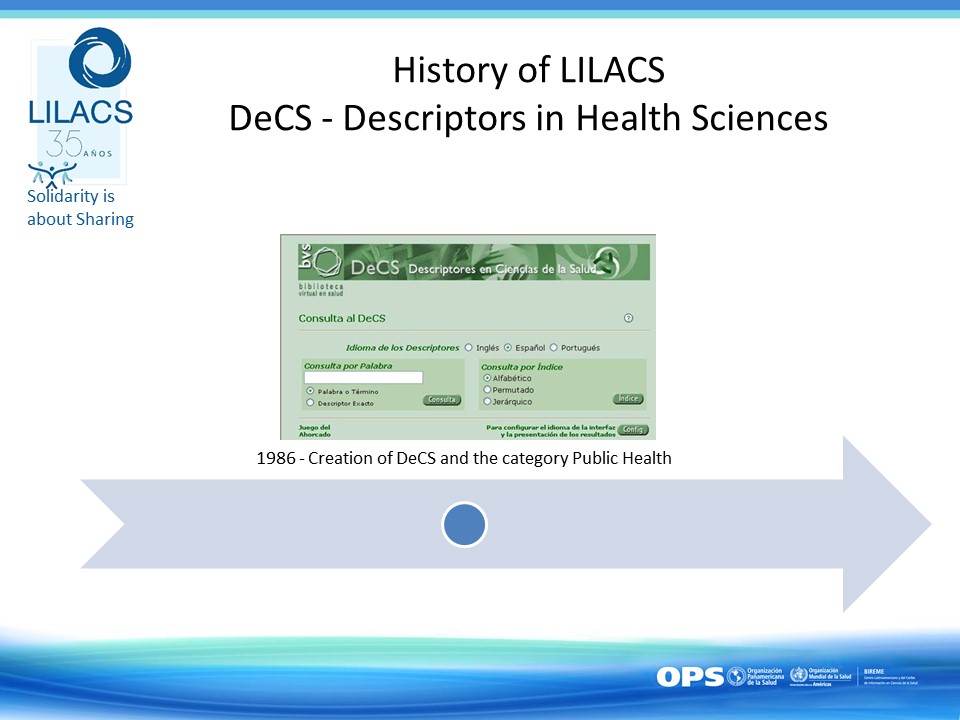 In 1987, the Latin American and Caribbean Health Sciences Information System was created, which established the governance of the network through the figure of the National Coordinating Center and specialized areas responsible for leading LILACS ‘actions in the country; Cooperating Centers, Libraries and Information Units responsible for compiling and registering the institutions’ production for LILACS; and PAHO Information Centers, as means of BIREME’s action in the countries.
In 1987, the Latin American and Caribbean Health Sciences Information System was created, which established the governance of the network through the figure of the National Coordinating Center and specialized areas responsible for leading LILACS ‘actions in the country; Cooperating Centers, Libraries and Information Units responsible for compiling and registering the institutions’ production for LILACS; and PAHO Information Centers, as means of BIREME’s action in the countries.
For creating the System, the following national health information networks joined or were formed to participate in the initiative:
- National Biomedical Documentation or Information System SINADIB (Venezuela) – founded in 1974
- Health Information System (Ecuador) – founded in 1977
- Colombian Health Sciences Information Network (Colombia) – founded in 1985
- Renics – National Health Sciences Information Network (Argentina) – founded in 1986
- Repebis – Peruvian Health Library Network (Peru) – founded in 1987
- Surenf – Brazilian Nursing Sub-Network – founded in 1987
- Redidosah – Documentary Health Information Network in Honduras – founded in 1987
- Bolivian Health Information Network (Bolivia) – founded in 1988
- SIEO – Information System Specialized in Dentistry – 1991[1]
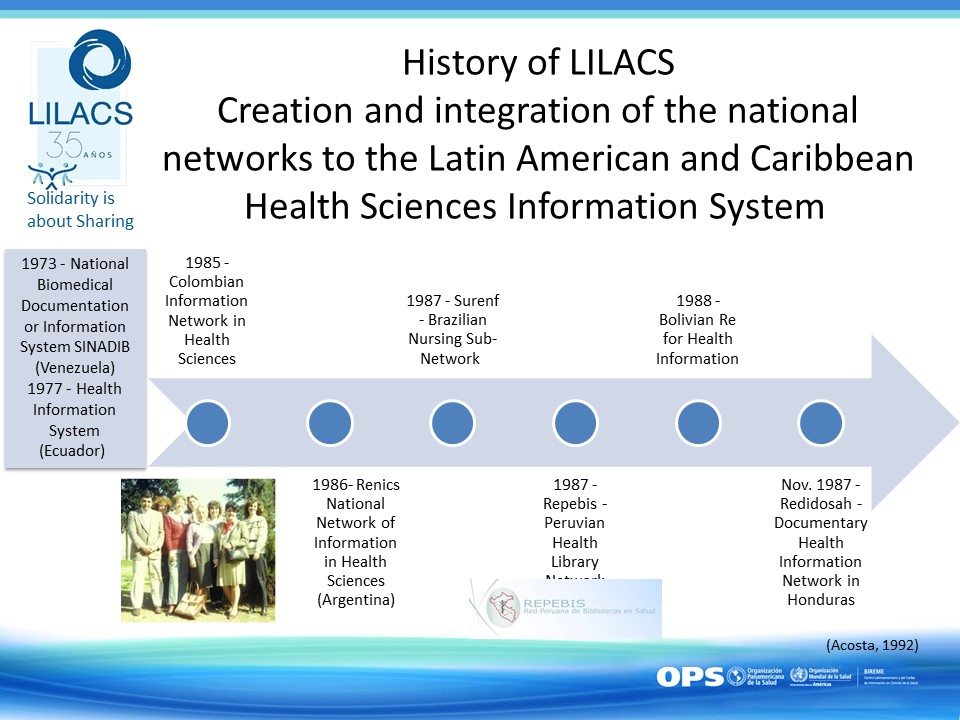 In 1988, the LILACS CD-ROM with scientific information from 26 countries was launched. It was the first scientific data CD-ROM in the world. During this period, decentralization was achieved through this CD-ROM and the distribution of 110 desktops to the main cooperating centers.
In 1988, the LILACS CD-ROM with scientific information from 26 countries was launched. It was the first scientific data CD-ROM in the world. During this period, decentralization was achieved through this CD-ROM and the distribution of 110 desktops to the main cooperating centers.
During the period, training missions were carried out by BIREME’s cooperating centers to contribute to LILACS and in 1992 the decentralization of the evaluation and selection of journals indexed in LILACS took place for the national and thematic coordinators of the System and the launch of the DBAC (Bibliographic Description aided by computer) and DCAC (computer-aided content description) for network use.
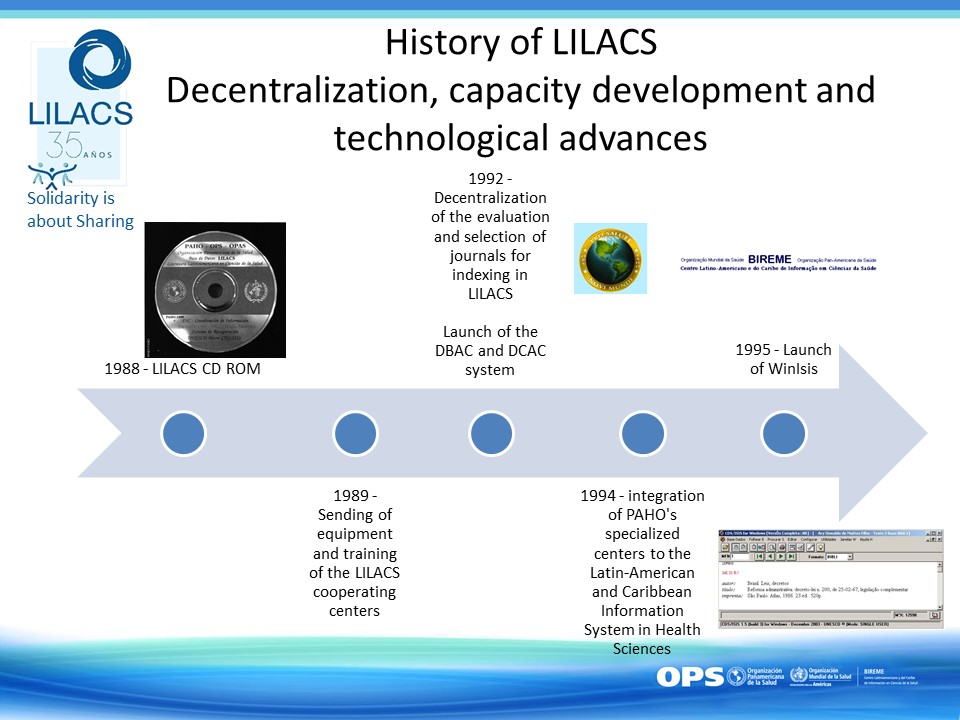 From 1994, LILACS was made available for access to the Internet in the text mode interface and in 1996 with a web interface with iAH search interface – (Access to Health Information Interface) and use of the LILDBI system with consultation to the DeCS integrated in the system.
From 1994, LILACS was made available for access to the Internet in the text mode interface and in 1996 with a web interface with iAH search interface – (Access to Health Information Interface) and use of the LILDBI system with consultation to the DeCS integrated in the system.
In 1996, BIREME carried out an evaluation study of 311 Latin American journals indexed in MEDLINE and LILACS in order to define a model form that could be used for the initial analysis of journals candidates for indexing in LIILACS.
In 1998, the Virtual Health Library interface was launched, with LILACS, SciELO – Scientific Eletronic Library Online, the collection of journals with access to the full text and information sources, Events Directory, Health Information Locator and Scientific journals portal in its collection.
In 2000, the selection process of journals for LILACS was systematized and the first Meeting of the Selection Committee of LILACS Brasil (ad hoc) was held to start indexing in 2001.
In 2003, the LILACS-Express process was launched, which consists of collecting SciELO data for publication in LILACS to give quick dissemination and visibility of the production in the database, but the records continued without thematic indexing.
The year 2006 was marked by a major methodological update in order to make the LILACS Methodology compatible with the MARC format to promote the development of databases for recording production in other formats and supports such as videos and photos, and this update culminated in the launch of new version of LILDBI-Web.
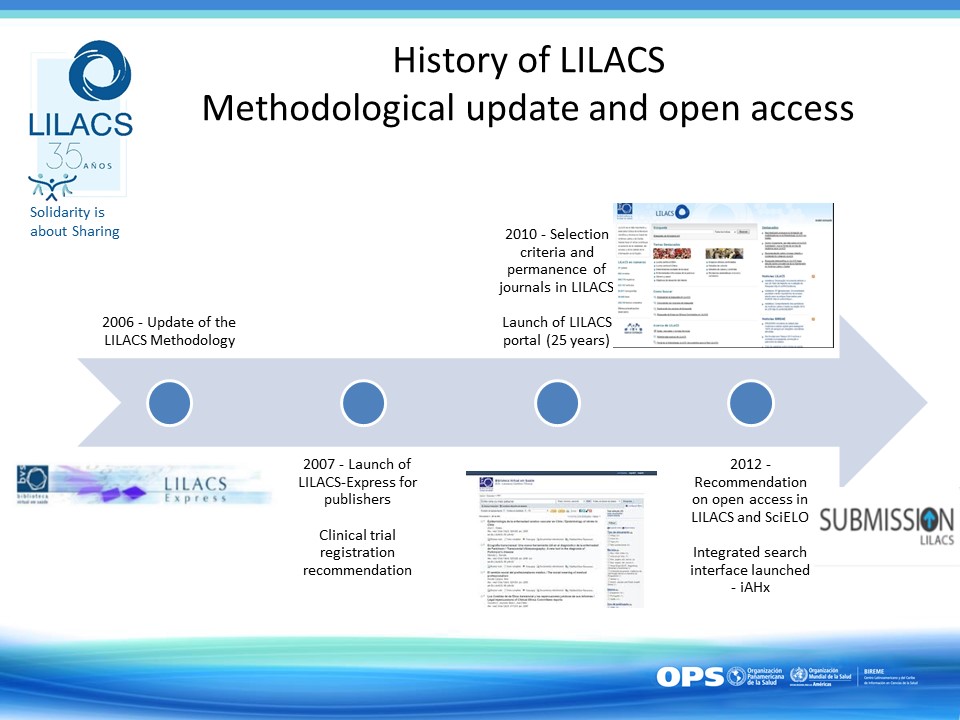 In the following year (2007), the LILACS-Express system was launched, which opened the possibility for journal editors indexed in LILACS, but not indexed in SciELO, to send their data and have the records made available as soon as possible.
In the following year (2007), the LILACS-Express system was launched, which opened the possibility for journal editors indexed in LILACS, but not indexed in SciELO, to send their data and have the records made available as soon as possible.
In 2008, the Criteria for Selection and Permanence of Journals include the recommendation to grant open access to publications indexed in LILACS and the journal evaluation process for LILACS Brasil starts to be carried out with the documentation published on its own website, without printing and without sending documentation by mail.
In 2009, the LILACS Brazil Review and Selection Committee was formed, composed of members representing the areas of Medicine (Clinical and Surgical), Public Health (including Nutrition), Pharmacy, Physical Education (Speech Therapy, Physiotherapy, Occupational Therapy and Medicine) Sports), Biomedical Sciences, Dentistry, Psychology and Nursing.
In 2010, the LILACS search portal was launched, and the first LILACS Methodology online course was offered to the Brazilian Health Sciences Information Network.
In 2012, the Recommendation on Open Access and Online Content was published at LILACS and the LILACS Submission was launched, a system for sending contribution data to LILACS (files in ISO format that were previously sent by e-mail).
 In 2014, in order to improve the quality of the records that brought links to the full texts, the Social Check Links system was launched to identify and correct broken links at LILACS. In the same period, the FI-Admin system for Events Directory and Health Information Locator was launched as a test for its use in LILACS administration.
In 2014, in order to improve the quality of the records that brought links to the full texts, the Social Check Links system was launched to identify and correct broken links at LILACS. In the same period, the FI-Admin system for Events Directory and Health Information Locator was launched as a test for its use in LILACS administration.
Considering the good results obtained in the test, in 2016 the module of bibliographic records was launched in the FI-Admin system, an online LILACS management system and the migration of LILACS from the ISIS platform to FI-Admin, from the MySQL platform.
In 2017, LILACS monthly training and meetings on the virtual platform began. In this first year, an introductory course on indexing documents by the LILACS Methodology and meetings of the LILACS Coordination was offered.
In the same year, LILACS coordinators were recommended to set up Periodical Evaluation and Selection Committees for indexing at LILACS and the Brazilian Dental Bibliography – BBO was migrated to the FI-Admin system.
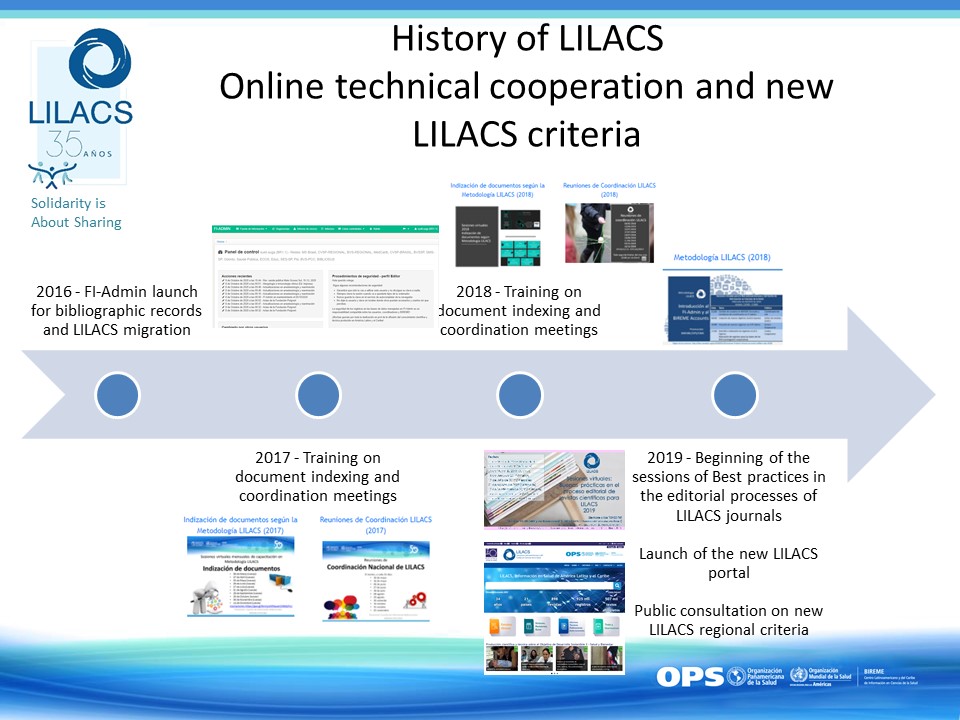 In 2018, with the LILACS Network recognition and incentive program for participation in CRICS10, more than 100 network members were awarded and participated in the event. The Document Indexers Network was also created according to the LILACS Methodology.
In 2018, with the LILACS Network recognition and incentive program for participation in CRICS10, more than 100 network members were awarded and participated in the event. The Document Indexers Network was also created according to the LILACS Methodology.
In 2019, in celebration of 34 years of LILACS, the new LILACS portal was launched, and the first public consultation was held on the new criteria for the selection and permanence of journals at LILACS, including updates for Open Science.
In 2020, the criteria for selection and permanence of LILACS journals was launched and the LILACS Submission system was closed, finalizing the last system that made it possible to contribute to LILACS using ISIS technology.
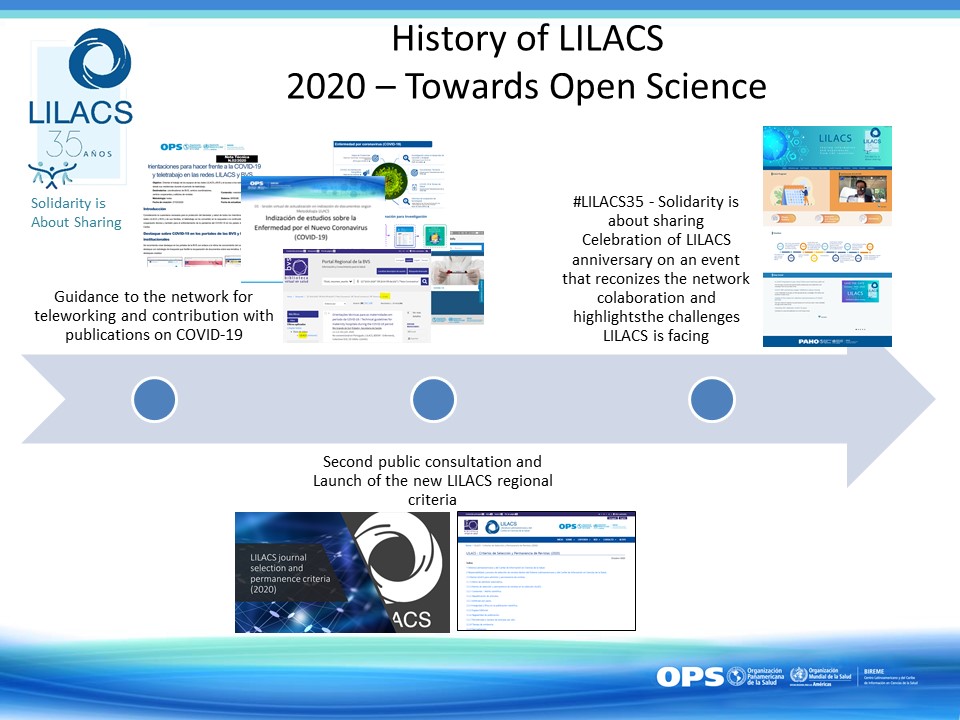 At the moment, LILACS’ history is not closed, on the contrary, there are still many challenges such as the legacy of ISIS that is still in use by the network for the management of national and thematic databases; the interoperability of systems with much simpler metadata and which do not provide the minimum structure necessary to contribute to LILACS; management and continuous training of the network to cover all relevant and quality literature and, undoubtedly, Open Science, with important changes in scientific publication flows that impact journal editors and LILACS in their production processes. But, just as LILACS reaches 35 years of age with sustainability and maturity, it will continue together with the Network, which is the most important asset in its mission of providing scientific evidence to respond to health issues in Latin America and the Caribbean.
At the moment, LILACS’ history is not closed, on the contrary, there are still many challenges such as the legacy of ISIS that is still in use by the network for the management of national and thematic databases; the interoperability of systems with much simpler metadata and which do not provide the minimum structure necessary to contribute to LILACS; management and continuous training of the network to cover all relevant and quality literature and, undoubtedly, Open Science, with important changes in scientific publication flows that impact journal editors and LILACS in their production processes. But, just as LILACS reaches 35 years of age with sustainability and maturity, it will continue together with the Network, which is the most important asset in its mission of providing scientific evidence to respond to health issues in Latin America and the Caribbean.
Further information is available at: https://lilacs.bvsalud.org/35anos/en/timeline/
[1]BBO – Bibliografia Brasileira de Odontologia is a Dentistry database that started to be published in 1966, but the network was founded in 1991. This database was part of the 17th edition of LILACS CD-ROM.